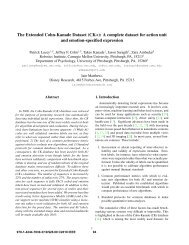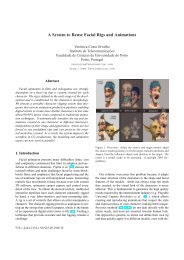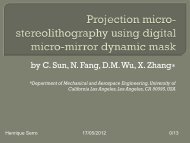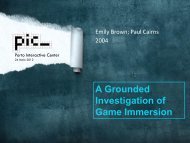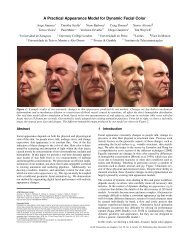Creating the Virtual Self: Re-Using Facial Animation in Different ...
Creating the Virtual Self: Re-Using Facial Animation in Different ...
Creating the Virtual Self: Re-Using Facial Animation in Different ...
Create successful ePaper yourself
Turn your PDF publications into a flip-book with our unique Google optimized e-Paper software.
<strong>Creat<strong>in</strong>g</strong> <strong>the</strong> <strong>Virtual</strong> <strong>Self</strong>: <strong>Re</strong>-<strong>Us<strong>in</strong>g</strong> <strong>Facial</strong> <strong>Animation</strong> <strong>in</strong><strong>Different</strong> AvatarsVerónica Costa Orvalho, Antonio Sus<strong>in</strong>Laboratorio de Simulació D<strong>in</strong>àmicaUniv. Politècnica de Catalunyaveronica.orvalho@FaceInMotion.com; toni.sus<strong>in</strong>@upc.eduhttp://www.ma1.upc.edu/ sus<strong>in</strong>/Figure 1: Source model (left) and target models (middle and right). (Image Louvre Museum fromhttp://www.louvre.fr) (3D models Copyright 2007 Face In Motion)Abstract<strong>Creat<strong>in</strong>g</strong> by hand <strong>the</strong> facial rig for each avatar is time-consum<strong>in</strong>g. We developed an application, implement<strong>in</strong>g a noveldeformation method, that automatically transfers rig and animations between characters, 90-99% faster than traditionaltechniques. Our technology can be embedded <strong>in</strong>to virtual environment frameworks to quickly create new avatars and easilycustomize <strong>the</strong>m.1 IntroductionModify<strong>in</strong>g how an avatar looks, behaves or can be controlled is critical to <strong>the</strong> development of collaborativevirtual environments. <strong>Facial</strong> animation of avatars can help communication between <strong>the</strong> system and <strong>the</strong> user,provide a lifelike experience by enhanc<strong>in</strong>g dialogue and enable casual and naive users to <strong>in</strong>teract <strong>in</strong> a naturalway with complex applications. Common applications <strong>in</strong>clude: virtual guides, help desk, website navigationand o<strong>the</strong>rs. Yet, <strong>the</strong>se virtual characters are not prepared to reproduce strong emotions and <strong>the</strong> quality hasn’treached <strong>the</strong> aes<strong>the</strong>tics that can commonly be appreciated <strong>in</strong> films.While try<strong>in</strong>g to develop a new approach to reproduce <strong>the</strong> subtleties of an avatar’s facial animation, we immediatelycame <strong>in</strong>to a roadblock: creat<strong>in</strong>g a sophisticated rig by hand is a very labor-<strong>in</strong>tensive and time-consum<strong>in</strong>gtask. To overcome it, we developed a method that automatically transfers <strong>the</strong> rig and animations of a face from<strong>the</strong> source to <strong>the</strong> target model. The rigg<strong>in</strong>g process is analogous to sett<strong>in</strong>g up <strong>the</strong> str<strong>in</strong>gs that control a puppet.Given a face model we analyze it and create a rig ready to be animated based on <strong>the</strong> source model <strong>in</strong>formation.Our method is general and <strong>in</strong>dependent of <strong>the</strong> model: artists can def<strong>in</strong>e <strong>the</strong>ir own rig and <strong>the</strong>n quickly applyit to different models, even with dissimilar proportions and look (human, cartoon or fantasy).We aim to <strong>in</strong>clude <strong>in</strong> virtual environments visual appeal<strong>in</strong>g characters capable of transmitt<strong>in</strong>g emotion andbehavior that would add to current applications a unique experience, which is currently impossible to achieve,due to <strong>the</strong> lack of a system that can automatically customize different characters on <strong>the</strong> fly.2 Background<strong>Facial</strong> <strong>Animation</strong> is based on ideas pioneered by Parke [Par72] (for a detailed review see [HTP ∗ 04]). Earlywork <strong>in</strong>cludes Platt and Badler [PB81], who built a face model capable of simulat<strong>in</strong>g and animat<strong>in</strong>g nonrigidobjects us<strong>in</strong>g masses and spr<strong>in</strong>gs, and classified <strong>the</strong> units of motion us<strong>in</strong>g <strong>Facial</strong> Action Cod<strong>in</strong>g System(FACS) [EF78]. S<strong>in</strong>ce <strong>the</strong>n, many approaches have emerged that can be classified <strong>in</strong>to 3D geometric manipulation,like key-frame <strong>in</strong>terpolation, parameterization and physically-based [KHYS02], or 2D image manipulation,like morph<strong>in</strong>g and blendshapes (for a survey on this techniques refer to [NN98]). Our application isrelated to rigg<strong>in</strong>g [CBC ∗ 05], which benefits from a comb<strong>in</strong>ation of many of <strong>the</strong> previous techniques. Noh andNewumann [NN01], <strong>in</strong>spired by motion re-target<strong>in</strong>g [Gle98], proposed a method for clon<strong>in</strong>g facial expressionsfrom an exist<strong>in</strong>g model to a new model us<strong>in</strong>g Hardy multiquadrics. Pigh<strong>in</strong> et al. [PHT ∗ 06] presented amethod to <strong>in</strong>teractively mark correspond<strong>in</strong>g facial features <strong>in</strong> several photographs of a person and to deform a
generic face model us<strong>in</strong>g radial basis functions, <strong>in</strong>terpolat<strong>in</strong>g <strong>the</strong> poses. None of <strong>the</strong>se methods deals directlywith <strong>the</strong> artists needs, and most are oriented towards human look.3 Animat<strong>in</strong>g <strong>Virtual</strong> CharactersToday, facial animation of avatars is typically done us<strong>in</strong>g pre-rendered animations of each character, <strong>in</strong>clud<strong>in</strong>gpre-def<strong>in</strong>ed phonemes and expressions, which are stored <strong>in</strong> a database and played back later based onautomatic text-to-speech or pre-recorded audio syn<strong>the</strong>sis. With our method, <strong>the</strong>re is no need to create <strong>the</strong>animations for each character; it allows hav<strong>in</strong>g multiple models already def<strong>in</strong>ed or creat<strong>in</strong>g new ones, and<strong>in</strong>stantly animate <strong>the</strong>m on demand.Our method beg<strong>in</strong>s with two 3D face models. The first one, we call source model, is rigged and <strong>in</strong>cludes aseries of attributes: a control skeleton, a number of <strong>in</strong>fluence objects that represent animation controls and<strong>the</strong> <strong>in</strong>ner structure of <strong>the</strong> face, facial expressions (shapes) and animation scripts. The rig doesn’t have <strong>in</strong>itialconstra<strong>in</strong>s and can be created by an artist. The second model, we call target model, doesn’t have a characterrig associated to it. The source and target models can have different descriptors: one can be def<strong>in</strong>ed as apolygonal mesh and <strong>the</strong> o<strong>the</strong>r as a NURBS surface. Also, <strong>the</strong> faces do not need to have a po<strong>in</strong>t-to-po<strong>in</strong>tcorrespondence (figure 2 shows an overview of <strong>the</strong> process).The method is based on geometric deformations techniques, which re-locate and re-shape <strong>the</strong> source modelattributes to fit <strong>the</strong> target model. As a result, <strong>the</strong> artist is now free to modify <strong>the</strong> target model, re-use <strong>the</strong>animation scripts of <strong>the</strong> source model or generate animations us<strong>in</strong>g both animation controls and sparse data<strong>in</strong>terpolation of <strong>the</strong> shapes (for a detailed description see [OZS06]).Figure 2: Overview: def<strong>in</strong>e <strong>the</strong> source and target model; adapt <strong>the</strong> source geometry to fit <strong>the</strong> target; transferattributes and shapes; b<strong>in</strong>d <strong>the</strong> <strong>in</strong>fluence objects and skeleton to <strong>the</strong> target. The result is a model ready to beanimated. (Copyright 2005 Dygrafilms)4 Application: <strong>Virtual</strong> GuidesThe primary motivation of our research was to f<strong>in</strong>d a solution that speeds up <strong>the</strong> rigg<strong>in</strong>g process for filmsand videogames. We developed an application based on our method, which is implemented <strong>in</strong> C++ as aplug-<strong>in</strong> for Maya 7.0 and can be <strong>in</strong>tegrated <strong>in</strong>to animation pipel<strong>in</strong>es. This can serve as <strong>the</strong> core technologyto be applied for <strong>the</strong> <strong>the</strong> content creation process of virtual characters, and can lead to to <strong>the</strong> development ofnew applications to be <strong>in</strong>tegrated <strong>in</strong>to exist<strong>in</strong>g virtual environment frameworks. <strong>Virtual</strong> guides for historicalheritage sites or museums are usually limited to a few characters, due to <strong>the</strong> time it takes to create multiplemodels. This limitation can be overcome <strong>in</strong> a three step process. First, <strong>the</strong> user def<strong>in</strong>es <strong>the</strong> new 3D characterfor <strong>the</strong> virtual guide, which can be created by sculpt<strong>in</strong>g it by hand or generated by a scanner. Second, us<strong>in</strong>gan application based on our technology, <strong>the</strong> user can transfer a sophisticated rig to <strong>the</strong> new character, whichbecomes ready to be animated. Last, <strong>the</strong> user can transfer <strong>the</strong> animations def<strong>in</strong>ed <strong>in</strong> <strong>the</strong> source model to <strong>the</strong>virtual guide character, which are later played back dur<strong>in</strong>g <strong>the</strong> virtual tour. For <strong>in</strong>stance, <strong>the</strong> default tour canbe guided by an avatar of an old lady, but at <strong>the</strong> request of <strong>the</strong> visitor can be <strong>in</strong>stantly changed to an avatarof a cartoon, a small child or a fantastic creature (figure 3 shows how animations can be transferred betweencharacters with different looks). Also, it is very easy to create or change <strong>the</strong> animations of <strong>the</strong> source modeland quickly propagate <strong>the</strong>m to all avatars.5 ConclusionThe method automatically transfers rig and animations between models, so new avatars can be <strong>in</strong>stantlycreated and animated with high quality by only provid<strong>in</strong>g <strong>the</strong> 3D model geometry. This, not only <strong>in</strong>creases <strong>the</strong>
number of avatars that can be available <strong>in</strong> any virtual environment, like a virtual guide tour around a city, butalso greatly augments <strong>the</strong> range of applications that can use avatars. Our approach allows to animate charactersthat before were devoid of expression, because of <strong>the</strong> time it takes to manually create a rig. Suddenly, all thosesecondary characters and avatars can come alive with <strong>the</strong> help of our technology.Figure 3: Transfer expressions and animations between models: <strong>the</strong> source (first row) and target have differenttriangulations. Notice <strong>the</strong> different proportions of <strong>the</strong> models: <strong>the</strong> source has a big nose and sk<strong>in</strong>ny face,while one target has a small nose and <strong>the</strong> o<strong>the</strong>r has a fat face. (Copyright 2005 Dygrafilms)6 AcknowledgementSpecial thanks goes to Xenxo Alvarez Blanco (great feedback), Rubén Lopez Ares and Juan Ramón PouCabanillas for Face In Motion’s 3D models and animations. We would also like to thank Juan Nouche fromDygrafilms and his team for 3D models and animations. A f<strong>in</strong>al thanks goes to João Orvalho for his review,feedback, comments and support.<strong>Re</strong>ferencesCAPELL S., BURKHART M., CURLESS B., DUCHAMP T., POPOVIĆ Z.:deformable characters. Eurographics ’05, Symp. on Computer <strong>Animation</strong>.Physically based rigg<strong>in</strong>g forEKMAN P., FRIESEN W.: <strong>Facial</strong> Action Cod<strong>in</strong>g System. Consult<strong>in</strong>g Psychologist Press, Palo Alto, CA, USA,1978.GLEICHER M.: <strong>Re</strong>targett<strong>in</strong>g motion to new characters. In SIGGRAPH ’98: Proc. of Conf. on Computergraphics and <strong>in</strong>teractive techniques (1998), ACM Press, pp. 33–42.HABER J., TERZOPOULOS D., PARKE F., WILLIAMS L., BLANZ V., BORSHUKOV G.: <strong>Facial</strong> model<strong>in</strong>gand animation. In SIGGRAPH ’04 (2004).KAHLER K., HABER J., YAMAUCHI H., SEIDEL H.-P.: Head shop: generat<strong>in</strong>g animated head models withanatomical structure. In SCA ’02: Proc. of ACM SIGGRAPH/Eurographics Symp. on Computer animation(2002), ACM Press, pp. 55–63.NOH J., NEUMANN U.: A survey of facial model<strong>in</strong>g and animation techniques, 1998.NOH J. Y., NEUMANN U.: Expression clon<strong>in</strong>g. In SIGGRAPH ’01: Proc. of Conf. on Computer graphicsand <strong>in</strong>teractive techniques (2001), ACM Press, pp. 277–288.ORVALHO V. C. T., ZACUR E., SUSIN A.: Transferr<strong>in</strong>g facial expressions to different face models. InSIACG’06: 3th Ibero-American Symposium <strong>in</strong> Computer Graphics (2006), Editors Brunet P., Correia N.,Baranoski G., pp. 21–28.PARKE F. I.: Computer generated animation of faces. In ACM’72: Proc. of <strong>the</strong> ACM annual Conf. (1972),ACM Press, pp. 451–457.PLATT S. M., BADLER N. I.: Animat<strong>in</strong>g facial expressions. In SIGGRAPH ’81: Proc. of Conf. on Computergraphics and <strong>in</strong>teractive techniques (1981), ACM Press, pp. 245–252.PIGHIN F., HAVALDAR P., TOLLES T., LEWIS J. P., BREGLER C., ZHANG L., SULLIVAN S., HERY C.,SAGAR M., KANG T., BORSHUKOV G.: Performance-driven facial animation. In SIGGRAPH ’06: ACMSIGGRAPH Courses (2006), p. 1.



